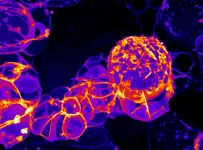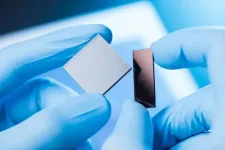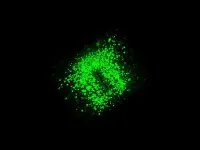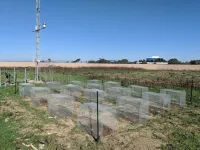Oregon researchers find cell division machinery that makes brain cells
High speed, super-resolution imagery suggests that neural stem cells in fruit flies operate like machinery on a factory floor
2021-05-19
(Press-News.org) EUGENE, Ore. -- May 19, 2021 -- High-resolution imaging of fruit flies at the University of Oregon has captured mechanical motions that stem cells use to make neurons, the cells that make up the brain.
These motions coordinate cell division with differentiation, where newly born cells become neurons. Differentiation is essential for building the brain circuitry in complex organisms that underlies human cognition and emotions, said Ken Prehoda, a professor in the UO's Department of Chemistry and Biochemistry.
Prehoda was principal investigator of a project published online May 18 in the journal Cell Reports.
Drosophila fly brains have some 100,000 neurons, while human brains have more than 50 billion. Developmental research in Drosophila often leads to advances in human medicine.
The discovery, Prehoda said, suggests that the mechanical process is vital to understanding brain development and, potentially, for regenerating neurons and their connections following injuries.
"To make so many neurons, the developing brain acts like a factory with individual stem cell 'machines' continually producing neurons," Prehoda said. "We discovered that stem cells have more in common with real machines on a factory floor than previously appreciated in that they undergo a mechanical cycle when producing each neuron."
In the project, Bryce LaFoya, a postdoctoral researcher in the UO's Institute of Molecular Biology, used spinning-disk confocal microscopy to examine fruit fly brains with their stem cell membranes embedded with fluorescent markers. That unveiled the membrane dynamics of neural stem cells and their progeny at high resolution, revealing the mechanical cycle as each neuron was produced.
To make neurons, Prehoda said, neural stem cells must place special molecules, proteins called fate determinants, into one of two daughter cells that result from division. How that was done had been unclear despite many previous studies of physical interactions in which fate determinants are involved.
In a 2019 study in the journal eLife, Prehoda and Krystal Oon, a graduate student in the Institute of Molecular Biology, reported that proteins undergo movements along the membrane, but what drove the movement was known.
"Mechanical forces within the cell segregate components that are responsible for cellular identity after division," LaFoya said. "After the cell divides in two, because of these forces, one cell will remain a stem cell while the other will go on to become a neuron."
The cellular-scale mechanical forces revealed in the imagery were so strong that surrounding cell membranes became highly distorted before returning to normal, Prehoda added. Understanding the process from beginning to end, he said, could have implications for regenerative therapies.
"Our results indicate that the neuroblast membrane plays a role in polarity initiation and maintenance," LaFoya and Prehoda wrote in their conclusion, describing the process that the neural stem cells use to make neurons.
INFORMATION:
The project, funded by the National Institutes of Health, was performed in the Prehoda Lab in the Institute of Molecular Biology. Imaging was done in the Genomics & Cell Characterization Core Facility with a spinning-disk confocal microscope purchased with a grant from the M.J. Murdock Charitable Trust through the UO Foundation.
Links:
Cell Reports paper: https://www.cell.com/cell-reports/fulltext/S2211-1247(21)00485-X
About Ken Prehoda: http://molbio.uoregon.edu/prehoda/
Prehoda Lab: http://molbio.uoregon.edu/keplab/
Institute of Molecular Biology: http://molbio.uoregon.edu/
Department of Chemistry and Biochemistry: https://chemistry.uoregon.edu/
[Attachments] See images for this press release:

ELSE PRESS RELEASES FROM THIS DATE:
2021-05-19
Researchers at UVA Cancer Center have unveiled important new insights into how hormones known as androgens act on our cells - and the discovery could boost efforts to develop better treatments for prostate, ovarian and breast cancers.
The findings shed light on how androgens interact with their receptors inside cells to affect gene activity. This process is important in both healthy cells and certain cancers. Hormone therapy for prostate cancer, for example, aims to reduce the amount of androgen in the body, or to stop it from fueling the cancer cells. However, ...
2021-05-19
Researchers at the National University of Singapore (NUS) and Tohoku University have demonstrated that an array of electrically connected spintronic devices can harvest a 2.4 GHz wireless signal, which can be used to power and charge small electronic devices and sensors.
The researchers from NUS and Tohoku University have successfully synchronized the four electrically connected magnetic tunnel junction (MTJ), for the signal transmission at 2.4 GHz. Furthermore, the eight MTJs array was integrated with the conventional battery-free electronics to harvest a wireless signal of 2.4 GHz to a DC signal, which is used to power light emitting ...
2021-05-19
In a world hungry for cheaper, more efficient renewable energy, Australian researchers have served up a treat.
Work led by the ARC Centre of Excellence in Exciton Science has shown that the two-dimensional (2D) thin films used in some perovskite solar cells closely resemble a sandwich. Perovskite is an exciting material at the forefront of solar energy research and design.
Previously, scientists thought these 2D perovskite films had a 'gradient' structure, in which certain components were found deep in the material, with other complementary elements only located nearer to the surface, like topping on a cracker.
However, in a paper published ...
2021-05-19
Nearly a quarter of pregnant women say they've been around secondhand smoke - in their homes, at work, around a friend or relative - which, according to new research, is linked to epigenetic changes - meaning changes to how genes are regulated rather than changes to the genetic code itself - in babies that could raise the risk of developmental disorders and cancer.
The study, published today in Environmental Health Perspectives by researchers at Virginia Commonwealth University Massey Cancer Center, is the first to connect secondhand smoke during pregnancy with epigenetic modifications to disease-related genes, measured at birth, which supports the idea that many adult ...
2021-05-19
While a pint-sized snorer may seem adorable tucked up in bed, studies shows that children with sleep disordered breathing are likely to show aggressive and hyperactive behaviours during the day.
The recommended treatment is an adenotonsillectomy - the removal of adenoid and tonsils - not only to fix the snore, but also the behaviour.
Yet according to new research from the University of South Australia, while the surgery can cure a child's snoring it doesn't change their behaviour, despite common misconceptions by parents and doctors alike.
Conducted in partnership with the University ...
2021-05-19
The nerve cells, also called neurons, in our brain control all the basic processes of our body. For this reason, there are different types of neurons distributed over specific regions of the brain. Researchers at the Max Planck Institute for Metabolic Research and the CECAD Cluster of Excellence in Aging Research of the University of Cologne have developed an approach that allows them to show that neurons that are supposedly the same are actually very different: they not only sense different hormones for the body's energy state, but also have a different influence on food intake. This can have a direct effect on our metabolism, for example by differentially restraining our appetite.
The brain processes our sensory perceptions, controls our behaviour and stores ...
2021-05-19
Traditionally, an infection is thought to happen when microbes - bacteria, fungi, or viruses - enter and multiply in the body, and its severity is associated with how prevalent the microbes are in the body.
Now, an international research team led by Nanyang Technological University, Singapore (NTU Singapore) has proposed a new way of understanding infections. Their study of close to 400 respiratory samples from patients with bronchiectasis, a chronic lung condition, has shown that microbes in the body exist as a network, and that an infection's severity could be a result of interactions between these microbes.
Through statistical modelling ...
2021-05-19
Among the large cast of microbiome players, bacteria have long been hogging the spotlight. But the single-celled organisms known as protists are finally getting the starring role they deserve.
A group of scientists who study the interactions between plants and microbes have released a new study detailing the dynamic relationships between soil-dwelling protists and developing plants, demonstrating that soil protists respond to plant signals much like bacteria do.
An enormous variety and diversity of microbes live in soil, and studying how these organisms interact with each ...
2021-05-19
For young plants, timing is just about everything. Now, scientists have found that herbivores, animals that consume plants, have a lot to say about evolution at this vulnerable life stage.
Once a plant seedling breaches the soil surface and begins to grow, a broad range of factors will determine whether it thrives or perishes.
Scientists have long perceived that natural selection favors early rising seeds. Seedlings that emerge early in the growing season should have a competitive advantage in monopolizing precious soil resources. Early growth also should mean more access to light, since early growers can block sunlight for seedlings that emerge later in the season.
Despite plenty of proof that germinating early is highly advantageous, many plants germinate ...
2021-05-19
LA JOLLA, CALIF. - May 19, 2021 - A study led by scientists at Sanford Burnham Prebys Medical Discovery Institute has identified a tumor marker that may be used to predict which breast cancer patients will experience resistance to endocrine therapy. The research offers a new approach to selecting patients for therapy that targets HER2, a protein that promotes the growth of cancer cells, to help avoid disease relapse or progression of endocrine-sensitive disease.
The study was published in the journal Nature Communications.
Nearly 80% of breast tumors are estrogen receptor (ER)-positive. For decades, ...
LAST 30 PRESS RELEASES:
[Press-News.org] Oregon researchers find cell division machinery that makes brain cells
High speed, super-resolution imagery suggests that neural stem cells in fruit flies operate like machinery on a factory floor








